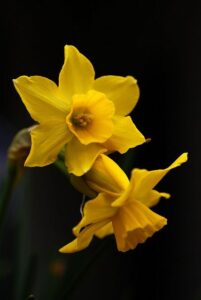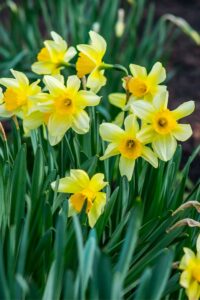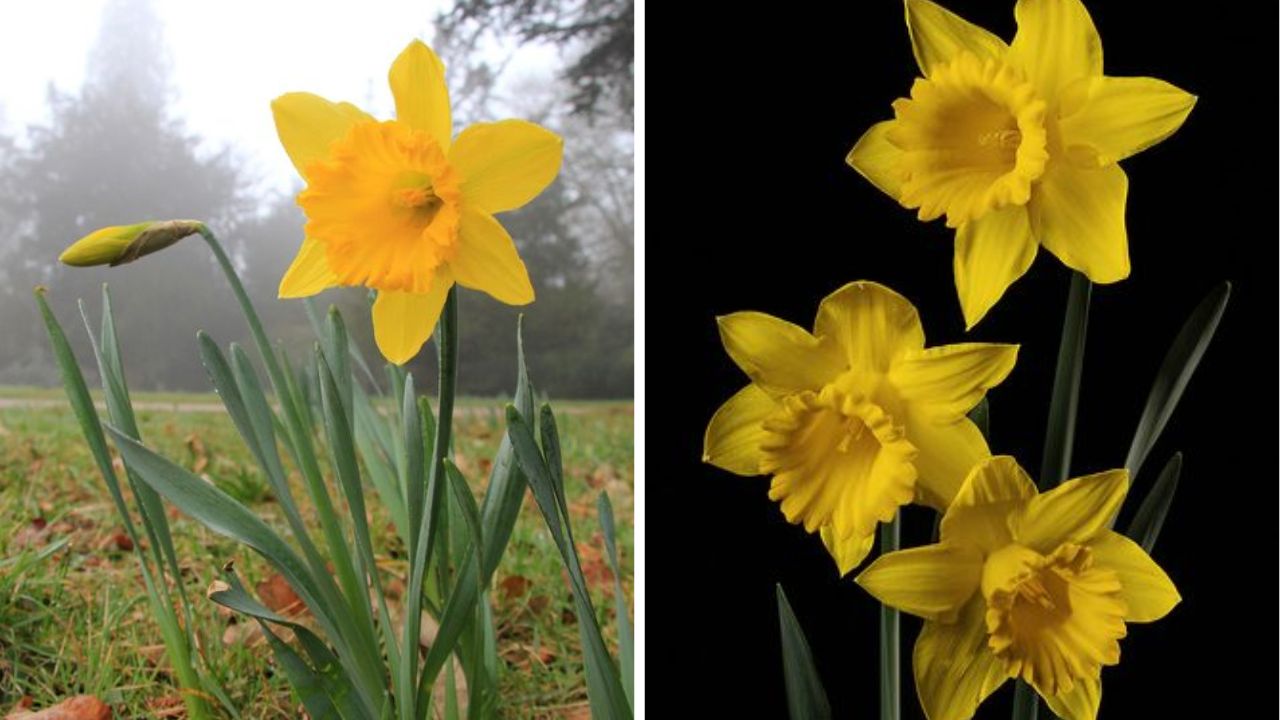The daffodil (Narcissus), a native of Europe and North Africa, is perhaps the best and most expensive spring bulb in the South. Daffodils have a long lifespan and spontaneously multiply every year. These flowers are hardy in the yard and don’t need much care, although they do demand a bit more winter frost than what’s found in the Coastal or Tropical South. They look as good in a farm’s untamed field, cottage border, or formal garden.
Every daffodil has the same fundamental floral structure. Every bloom features a center corona, also known as the trumpet or cup, depending on its length, that is surrounded by a perianth, which are six exterior segments that resemble petals and are held at a right angle. They have an amazing variety of flower shapes, sizes, and hues.
Winter in the Lower South and early spring in other regions mark the start of flowering. There are tones of orange, apricot, pink, cream, and even red in addition to the primary hues of yellow and white. Although they won’t be eaten by rodents or deer, you should be cautious about where you plant daffodils because all of their parts are poisonous to humans and animals.
Daffodil Plant Overview

| Common Name | Daffodil, Narcissus |
| Botanical Name | Narcissus |
| Family | Amaryllidaceae |
| Plant Type | Perennial, Bulb |
| Mature Size | 6–30 in. tall, 6–12 in. wide |
| Sun Exposure | Full, Partial |
| Soil Type | Moist but Well-drained, Rich |
| Soil pH | Acidic to Neutral (6.0 to 7.0) |
| Bloom Time | Winter, Spring |
| Flower Color | Pink, Orange, Yellow, White |
| Hardiness Zones | Zones 3-8 (USDA) |
| Native Area | Europe, Africa |
| Toxicity | toxic to dogs, toxic to cats, toxic to pets, toxic to people |
Daffodil Care

“Jonquil” and “daffodil” are terms that gardeners use interchangeably. Technically, a “daffodil” is any type with enormous flowers and flat, strap-like leaves. “Jonquil” refers to N. jonquilla and its hybrids, which have cylindrical leaves with quill-like points and tiny, fragrant, clustered blossoms. You’ll be safe if you keep calling them all “narcissus.”
All daffodils flourish when planted properly and require very little care afterward. Daffodils just need to be divided sometimes and don’t really need summer watering, but they will tolerate it. When they’re actively developing and blooming, give them regular watering; once they go dormant, let them.
Light Requirements
For the best bloom, daffodils require full sun, or at least six hours of direct sunlight each day while they are growing. Although daffodils can withstand some shade, when planting, keep in mind that the flowers will be facing the sun.
Soil and Potting

Grow daffodils in forest and rock gardens, borders, amid ground cover plantings, and beneath high-branching trees and blooming shrubs. Because daffodil bulbs can easily rot, it is best to plant them in well-draining soil that has a pH of either neutral or slightly acidic. Rich, fertile soil that is loose or loamy is ideal for bulb growth.
Plant them in an elevated bed or on a mound if your soil is thick and poorly draining. When planting, work the soil loose and enrich clay with a planting mix or well-rotted compost. Additionally, potting soil-filled containers are used to nurture these flowers. The pointed end of a bulb should be planted at least twice as deep as the bulb’s overall size.
Watering
During their growth, these blooms require a lot of water—roughly one inch each week through rainfall or hand watering. To check if the earth is dry, feel it with your hands. Although they require watering to get established, daffodils are typically low-maintenance plants because you stop watering them roughly three weeks after they bloom. If you live in an extremely dry region, you might need to water the bulbs frequently both in the spring and in the winter after planting.
Temperature and Environment
When the weather has dropped off in the fall—which in the South could mean as late as November—daffodil bulbs should be planted. The plants do not grow well in frost-free locations because they need cold treatment to create flower buds. Although the bulbs are quite resistant to winter, colder locations should plant them deeper—roughly 6 inches as opposed to 4 inches.
Daffodils prefer well-draining soil, but they do not mind dampness. When the plants are actively growing, a little mulch helps retain moisture; when the bulbs are dormant in the summer, it keeps them cooler.
Fertilization
Narcissus bulbs require fertilizer, just like any other plant. Don’t bother with bone meal; it’s not a full fertilizer and takes a long time to break down. When getting ready to plant, incorporate a low-nitrogen fertilizer, like a 3-6-6 or a 5-10-10, into the soil at a rate of approximately 1/4 cup per square foot of the growth area. When the spring leaf tips appear, you can fertilize again with a low-nitrogen fertilizer. Every autumn, some gardeners also apply bulb fertilizer to the bulb bed according to the amount recommended on the package, which they then either scrape or water in.
Types of Daffodils
There are numerous species of Narcissus as well as thousands of cultivars. Daffodil variations are divided into 13 categories, each with its own distinct size, color, and form. Trumpet, Large-cupped, Small-cupped, Double, Triandrus, Poeticus, Jonquilla, Tazetta, Bulbocodium, Split-cupped, Miscellaneous, and wild variations are among the divisions. The following are some particular daffodil kinds that are frequently found in the South:
‘Dutch Master’: One of the most extensively grown daffodils in the world is this big trumpet variety. It can be used for naturalizing and has vivid yellow flowers.
‘Angel’s Tears’ (N. triandrus): Little white or pale yellow flower clusters arranged in clusters atop 10-inch rush-like leaf stems.
‘Pheasant’s Eye'(N. poeticus recurvus): An old favorite that grows to a height of one foot. Tiny yellow cup with a red rim, a green “eye” in the center, and segments that are reflexed pure white.
‘Lent Lily’ (N. pseudonarcissus): One of the daffodils that have been cultivated since the year 1200 A.D. With long yellow cups and twisted yellow perianth segments that sweep forward, giving the blossoms a dog-ear appearance, this plant reaches a height of 12 to 14 inches.
‘Twin Sisters’ (N. medioluteus): reaches a height of 14 inches and bears two little yellow cups surrounded by white segments on each stalk of blooms. It is typically the final daffodil of the season and a very late bloomer.
‘Hoop Petticoat Daffodil’ (N. bulbocodium): reaches a height of six inches. Most trumpet-shaped flowers are small, upward-facing blossoms with extremely tiny, pointy perianth segments. Both light and deep yellow options are offered. Because it spreads by seed, naturalizing is an excellent use for it.
‘Jonquil’ (N. jonquilla): Leaves that are semicylindrical, upright, and spread like a rush. Clusters of short-cupped, up to one-foot-tall, early, highly fragrant golden yellow blooms.
Pruning
Allow the leaves to organically grow and become yellow once the petals have faded, then trim them back. Cutting the foliage before it becomes yellow might minimize or completely stop further flowering. Bulbs can regenerate if leaves are left on the plants; this usually happens eight weeks after flowers appear.
An aspect of caring for daffodils is dividing them when they become too big and take up too much room. As the blossoms become smaller and smaller, lift and divide the bunches. Dig clumps shortly after the foliage withers so you can locate the bulbs more easily. Replant the bulbs in newly amended and fertilized soil after separating them.
Daffodils only look good in vases with other daffodils, but they also make great-cut flowers. A chemical released by freshly cut stems makes other cut flowers wither.
Propagating Daffodil Flowers
Daffodils can be multiplied easily and effectively through division, as the flowers are grown from bulbs. It’s not always necessary to divide. Once plants are established, divide them every four years or when flowering stops or the plants crowd the growing space to maintain the daffodils healthy. Here’s how to divide daffodils to spread them:
- Trim back plant foliage to three inches when daffodils turn yellow and start to dry, which is usually six to eight weeks after blossoms die.
- Dig around the daffodil bulb using a garden fork, about four inches from the base of the plant. Take care not to damage the bulbs when removing the clump of daffodils. The soil may need some time to separate from the ground.
- After removing any extra dirt, check the bulbs for any damage or soft places. Throw away any broken bulbs.
- Break off the new bulbs gently from the larger parent bulb. Twist two bulbs in opposite directions until they snap to separate the bulbs. Smaller bulbs will take longer to blossom; bulbs larger than 1.5 inches in diameter have the highest chance of doing so the next year.
- New bulbs can be stored for the following season or replanted immediately, spaced 10 to 12 inches apart, and planted at a depth at least twice as wide as the original bulb. When planting, give the bulbs plenty of water.
- If you want to keep bulbs for next year, store them in a cold, dark place. Plant bulbs as soon as fall bulb harvesting season begins, ideally two to four weeks before the ground freezes. They should be devoid of discoloration and have a substantial, weighty feel. The largest and most abundant flowers will be produced by “double-nose” bulbs in the first growing season.
How To Grow Daffodils From Seed?

It is possible to grow daffodils from seeds, albeit it is more difficult than starting with bulbs. It also takes longer to grow from seeds, typically five or six years. When the petals fade, start gathering seeds from the daffodil pods. As soon as the pods start to turn brown and shrink, you will know it’s time.
Using a clean, sharp knife or your fingers, gently crack open the seeds. Store the seeds in a cold, dark place until fall, when you can plant them in a tiny container or seed-starting tray, approximately half an inch thick. Put potting mix in the containers, then wait for the seeds to sprout into seedlings. Grow the seeds in the tray for around three years, or until little bulbs appear that need to be moved to bigger pots.
Potting And Repotting Daffodils
Another option is to grow daffodils in pots in the fall and store them throughout the winter in a protected area. Choose a container that is at least 12 inches deep and 8 to 12 inches wide, with drainage holes. Add a potting mixture that drains well to about two-thirds of the way. Place the bulbs in the pot with their tips facing up, close together but not touching. After that, fill the bulbs with dirt.
The container can be kept in a cool, dark place with comfortable temperatures. For around three months, the temperature should stay between 40°F and 45°F, and the soil should continue to be somewhat damp. An alternative would be to bury the entire pot underground and take it out come spring. When it reaches between 50 and 65 degrees Fahrenheit, move it to a sunny place. When the soil is dry, add water. The bulbs can be planted in the ground or thrown out once blooming is finished.
Overwintering
Daffodils may withstand some degree of cold depending on the species and the conditions of their habitat. In places where there is no snow cover, adding a layer of mulch can assist regulate soil temperature and moisture.
Common Pests & Plant Diseases
Due of their toxicity, deer and rats avoid eating the bulbs. The narcissus bulb fly is the most dangerous daffodil pest. A mature fly looks like a tiny bumblebee. On the leaves and necks of bulbs, the female deposits her eggs. Young grubs munch their way into bulbs after eggs hatch. Prior to planting, inspect the bulbs and get rid of any grubs.
Infestations can be decreased by planting at the suggested depth. The daffodil is susceptible to various pests, including the narcissus bulb fly. Other pests include nematodes, which, when identified in the soil, may require transplanting to a different place, and bulb mites, which are more likely to harm daffodils growing inside.
Bulb rot is one disease that daffodils are susceptible to, and it happens when blooms are planted in damp or poorly draining soil. When inadequate watering, sunlight, or soil nutrients affect the health of the bloom, daffodil plants experience several forms of rot and blight.
How To Get Daffodils to Bloom
When appropriate food storage levels are maintained in the bulbs, daffodils consistently blossom. Cutting off leaves too soon will prevent daffodils from regrowing the plant for the following year after flower blooms fade, so wait until the foliage dies down naturally. Bulbs will also be weaker the next year if foliage is removed.
Make sure you plant daffodil bulbs appropriately and exclusively with mature bulbs. Smaller bulbs bloom later after being split off from the parent plant. Bud development can be aided by fertilizers, but exercise caution when applying too much fertilizer to a certain region. Maintain the right amount of light exposure, shifting the bulbs if a section is too shadowed or overgrown. It’s usually time to dig up daffodils and transfer them to a better location when they cease flowering.
Common Problems With Daffodils
Although daffodils are trouble-free perennials, they still face certain difficulties.
Leaves Turning Black/Brown
Daffodil buds that are exposed to harsh weather conditions may become brown and desiccate before blossoming. Extremely hot or cold temperatures can cause brown buds to form. Furthermore, the foliage and blossoms may be impacted if the growing season is not kept sufficiently moist. When the ground freezes, it helps to apply an organic mulch layer around the base and bulbs to prevent brown leaves from splitting.
Leaves Turning Yellow
In the presence of the viral illness stripe, leaves may turn yellow. Sadly, there is no treatment for this illness, so you will have to remove and dispose of the daffodil bulbs. Since aphids are a pest that spread this virus, avoiding contact with the pest will help you avoid contracting the illness.

Pingback: Periwinkle Complete Guide To Grow And Care